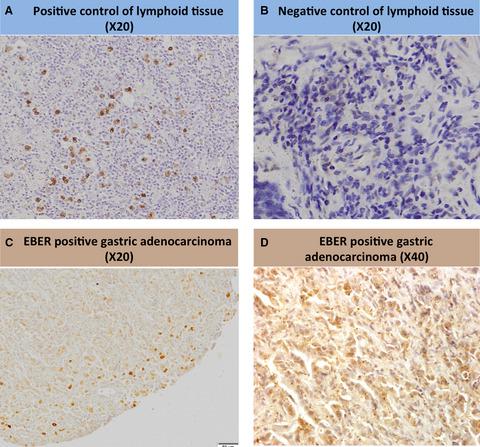当前位置:
X-MOL 学术
›
Cancer Med.
›
论文详情
Our official English website, www.x-mol.net, welcomes your
feedback! (Note: you will need to create a separate account there.)
Molecular profiling of gastric cancer in a population with high HIV prevalence reveals a shift to MLH1 loss but not the EBV subtype.
Cancer Medicine ( IF 2.9 ) Pub Date : 2020-03-24 , DOI: 10.1002/cam4.3001 Violet Kayamba 1, 2 , Julia Butt 3, 4, 5 , Tim Waterboer 5 , Ellen Besa 1 , Naheed Choudhry 6 , Anglin Hamasuku 7 , Peter Julius 2 , Douglas C Heimburger 8 , Masharip Atadzhanov 2 , Paul Kelly 1, 2, 6
Cancer Medicine ( IF 2.9 ) Pub Date : 2020-03-24 , DOI: 10.1002/cam4.3001 Violet Kayamba 1, 2 , Julia Butt 3, 4, 5 , Tim Waterboer 5 , Ellen Besa 1 , Naheed Choudhry 6 , Anglin Hamasuku 7 , Peter Julius 2 , Douglas C Heimburger 8 , Masharip Atadzhanov 2 , Paul Kelly 1, 2, 6
Affiliation

|
The human immunodeficiency virus (HIV) pandemic heavily affects sub-Saharan Africa. It is associated with persistently active Epstein-Barr virus (EBV) infection. To determine if this translates into increased frequency of EBV-associated gastric cancer (EBVaGC), we evaluated molecular profiles of gastric cancer (GC) in Zambia. Patients with GC or premalignant gastric lesions were enrolled in Lusaka, Zambia. We used patients without any of these lesions as a control group. Chromogenic in situ hybridization (CISH) on tumor tissue was used to identify EBVaGC. To identify the microsatellite unstable subtype, immunofluorescence staining for MutL homolog 1 (MLH1) was used. Exposure to EBV and HIV was assessed serologically. We enrolled 369 patients (median age 52 years [IQR 41-65]; 198 (54%) female). Of these, 72 (20%) had GC and 35 (9%) had gastric premalignant lesions (PL). CISH identified EBVaGC in 5/44 (11%) of those with adequate tissue, while MLH1 loss was identified in 29/45 (64%). Both GC and PL were associated with the highest titers of antibodies to Early antigen-diffuse (OR 2.5, 95% CI 1.0-6.1, P = .048 and OR 3.9, 95% CI 1.1-12.9, P = .03, respectively) at high concentrations. Human immunodeficiency virus infection was associated with a range of antibodies to EBV, but not with any cancer subtype. Despite the association of HIV with persistent EBV, the proportion of EBVaGC in Zambia is similar to populations with a low prevalence of HIV infection. The proportion of microsatellite unstable tumors may be higher than other populations.
中文翻译:

对 HIV 高患病率人群中胃癌的分子分析显示,MLH1 缺失发生转变,但 EBV 亚型并未发生转变。
人类免疫缺陷病毒(HIV)大流行严重影响了撒哈拉以南非洲地区。它与持续活跃的 Epstein-Barr 病毒 (EBV) 感染有关。为了确定这是否会导致 EBV 相关胃癌 (EBVaGC) 发生率增加,我们评估了赞比亚胃癌 (GC) 的分子谱。赞比亚卢萨卡招募了患有胃癌或癌前病变的患者。我们使用没有任何这些病变的患者作为对照组。肿瘤组织显色原位杂交 (CISH) 用于鉴定 EBVaGC。为了鉴定微卫星不稳定亚型,使用了 MutL 同源物 1 (MLH1) 的免疫荧光染色。通过血清学评估暴露于 EBV 和 HIV 的情况。我们招募了 369 名患者(中位年龄 52 岁 [IQR 41-65];198 名(54%)女性)。其中,72 例 (20%) 患有 GC,35 例 (9%) 患有胃癌前病变 (PL)。 CISH 在 5/44 (11%) 具有足够组织的患者中发现了 EBVaGC,而在 29/45 (64%) 的患者中发现了 MLH1 丢失。 GC 和 PL 均与早期抗原扩散抗体的最高滴度相关(分别为 OR 2.5、95% CI 1.0-6.1、P = 0.048 和 OR 3.9、95% CI 1.1-12.9、P = 0.03)在高浓度下。人类免疫缺陷病毒感染与一系列 EBV 抗体相关,但与任何癌症亚型无关。尽管 HIV 与持续性 EBV 存在关联,但赞比亚 EBVaGC 的比例与 HIV 感染流行率较低的人群相似。微卫星不稳定肿瘤的比例可能高于其他人群。
更新日期:2020-03-24
中文翻译:

对 HIV 高患病率人群中胃癌的分子分析显示,MLH1 缺失发生转变,但 EBV 亚型并未发生转变。
人类免疫缺陷病毒(HIV)大流行严重影响了撒哈拉以南非洲地区。它与持续活跃的 Epstein-Barr 病毒 (EBV) 感染有关。为了确定这是否会导致 EBV 相关胃癌 (EBVaGC) 发生率增加,我们评估了赞比亚胃癌 (GC) 的分子谱。赞比亚卢萨卡招募了患有胃癌或癌前病变的患者。我们使用没有任何这些病变的患者作为对照组。肿瘤组织显色原位杂交 (CISH) 用于鉴定 EBVaGC。为了鉴定微卫星不稳定亚型,使用了 MutL 同源物 1 (MLH1) 的免疫荧光染色。通过血清学评估暴露于 EBV 和 HIV 的情况。我们招募了 369 名患者(中位年龄 52 岁 [IQR 41-65];198 名(54%)女性)。其中,72 例 (20%) 患有 GC,35 例 (9%) 患有胃癌前病变 (PL)。 CISH 在 5/44 (11%) 具有足够组织的患者中发现了 EBVaGC,而在 29/45 (64%) 的患者中发现了 MLH1 丢失。 GC 和 PL 均与早期抗原扩散抗体的最高滴度相关(分别为 OR 2.5、95% CI 1.0-6.1、P = 0.048 和 OR 3.9、95% CI 1.1-12.9、P = 0.03)在高浓度下。人类免疫缺陷病毒感染与一系列 EBV 抗体相关,但与任何癌症亚型无关。尽管 HIV 与持续性 EBV 存在关联,但赞比亚 EBVaGC 的比例与 HIV 感染流行率较低的人群相似。微卫星不稳定肿瘤的比例可能高于其他人群。











































 京公网安备 11010802027423号
京公网安备 11010802027423号